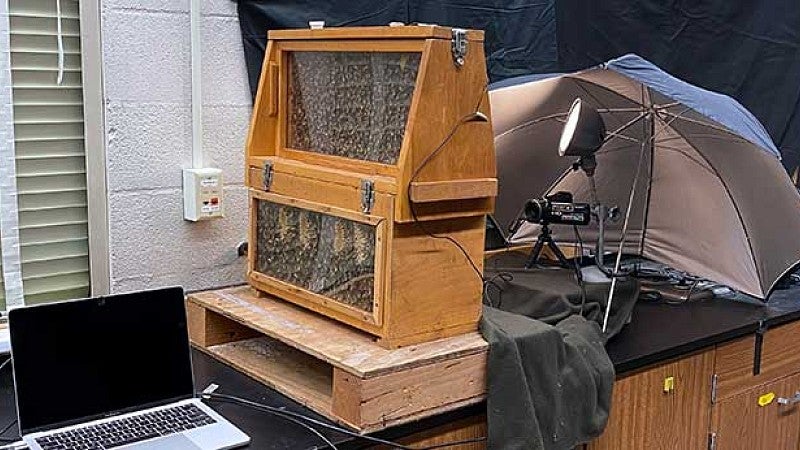Thanks to a live web cam focused on a beehive inside Huestis Hall, UO biology students are using modern technology to study insect dances that are millions of years old.
It’s just one more way UO students and faculty members found high-tech alternatives to traditional labs and classrooms as the university made a quick pivot to remote learning.
“Bees are fascinating, and they’re model organisms for studying behavior,” said Peter Wetherwax, research assistant professor of biology. “Any typical biology textbook has a chapter on bees that covers the research of Karl von Frisch, a Nobel Prize winner who was the first scientist to interpret the waggle dance that bees perform.”
Through this dance, bees communicate the direction and distance of food sources. From a hive on campus, for instance, a bee can fly out on a scouting mission, discover flowers at Hendricks Park and return to communicate with other bees about where to find that abundant source of nectar.
“It’s one of the few examples of animals using symbolic language,” Wetherwax said. “And to think this is an animal with a brain that’s smaller than a pea.”
“I miss the students, my colleagues and being in our labs,” she said. “But my role is to support the university’s biology courses, and I’m still doing that. It just looks different.”
To set up the hive, McLean-Schurbon collaborated with Oregon State University’s Honeybee Lab, which donated the bees and helped with maintenance. Adapting to remote learning has been a challenging transition, she said. But innovation is also what makes her job fun.
“There’s always something new to learn, and then we figure out how we can bring it into the classroom,” she said. “This spring could be an impetus for change. Maybe we will take some things we have discovered and incorporate them into our class curriculum.”
Remote beehive observation is a little less intimate. Without all the sounds and smells, Wetherwax said, field research isn’t quite the same. But it’s still engaged learning, in real time.
To teach students how to observe and interpret waggle dancing, lab preparators place sugar water in various locations around campus. Then they mark the bees that discover the sugar water. By observing those marked bees, students guess the distance and direction of the food source. Of course, this year they’re watching the bees on a camera feed.

Could they simply read a book or watch a prerecorded video? Of course, Wetherwax said. But there is no substitute for the live, unpredictable activity of observing nature, even if it’s on YouTube.
Students are able to see how weather affects the bees, for instance, or guess where flowers are blooming on campus. They also have opportunities to study behaviors that aren’t understood as well as waggle dancing. This allows for the trial and error of authentic scientific experimentation, Wetherwax said, pushing students to go beyond memorization and rote learning.
“We want students doing science,” he said. “That means careful observation, developing hypotheses, predicting results and deciding which results they should expect to support or refute their hypotheses. Plus, we thought the hive would help students remain connected to the UO and the biology department.”
Remote teaching has created challenges and led to surprising successes, Wetherwax said. Above all, it’s a lot of work, and he’s glad to be team-teaching the biology course with instructor Laurel Pfeifer-Meister.
“I can’t imagine doing all this on my own,” he said. “We’re learning as we go, making adjustments.”
Above all, he said he misses interacting with students and the live performance of teaching.
As a graduate student, Wetherwax didn’t work in a lab with research funds. He taught undergraduate courses. As a former pro musician from a family of musicians, he enjoyed performing in front of people for much of his life. Once he realized he could find the same joy and exhilaration from the lecture hall, he was hooked on teaching.
“I like lecturing in front of a large group, that energy you get from audience,” he said. “You can read when they’re bored, excited, confused. Zoom teaching is stretching me a bit, but I can imagine when I go back to face teaching how I might incorporate some new ideas.”
UO students — and anyone else — can see and hear the Huestis Hall bees any time on a biology department website.
“It’s really meditative,” Wetherwax said. “Turn off the news and turn on the beehive.”
—By Ed Dorsch, University Communications


